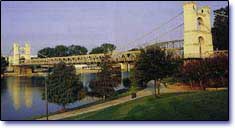

Places in Time
Waco's Bloodline Goes Parallel to Chalkline
By: John Young, Waco Tribune-Herald
I don't know how Baylor University's O. T. Hayward would feel about being confused with John Travolta, but don't do it. Travolta was an urban cowboy. Hayward is an urban geologist.
That might sound incongruous—like a frontier comedian or a sidewalk surfer. What's there to study about geology once you've conquered it with asphalt and high rises?
Plenty, of course. Waco's history has been dictated by the land under its feet. Hayward calls this "geological determinism."
Sunday at the Helen Marie Taylor Museum, Hayward said that to understand Waco's growth, just follow a chalk line and the path of upwardly mobile opossums. Hayward points out that Waco is where it is for the same reason Dallas is where it is, and Austin, too. Several cities, and some one-fifth of all Texans, lie near the outcrop called the Austin Chalk.
A hundred million years ago this land was under the sea. Layers of limestone formed on top of shale and clay. All was stable until about 30 million years ago. Then—upheaval in (what would be) River City. Underwater faults formed, shoving sections upward. Over time the layers eroded to where you had limestone and shale side by side. (Stay with me, because we're in the picture shortly.)
The seas receded. Along came the Brazos River and the Bosque. The Bosque carved into the more erodable shale and left the harder limestone layer exposed. Presto. You had a series of cliffs, or, the Bosque escarpment.
The fault line provided an ideal crossing for Indians and, eventually, settlers. Before long you had a city. You had streetcars. You had artesian springs making it possible to get water up to the top of the South's tallest skyscraper and to bottle a drink called Dr. Pepper.
Geology is destiny. Getting into the swing?
No one would consider such places as Sanger Heights and Castle Heights high altitudinally, but they are higher than some stretches along the Brazos. Settlers found out quickly you don't build a castle in a flood plain. Hence, you have underdeveloped East Waco -- a flood plain.
The only empire builders who didn't get the message were Hayward's eventual employers. Baylor's campus is in the Brazos flood plain.
Waco started out being a circular town, but geology dictated a less conventional shape. The first big delineator was the Brazos. But the next and biggest geologic influence was the limestone escarpment.
Hayward points out that people were drawn to the wooded acres of the escarpment for privacy and a view of the land below, especially the valley that would become Lake Waco. And when more people moved uphill, especially since they were people with money, business followed. The first big development was Greenway Plaza on 19th Street, he said.
People want to blame the decline of downtown on meteorology—the 1953 tornado. Wrong, says Hayward. Blame it on geology. Waco had become a "banana-shaped town" moving west and southwest along the escarpment, everybody vying for a view and stealing someone else's view. The money was out at one end and it didn't get to the other end (old downtown.)"
Now, Hayward points out that Waco is stratified. It is delineated by wealthy Republicans and possums up on the escarpment, and Democrats and pigeons (what party do grackles go along with?) closer to the flood plain.
Possums tied to Republicans? Of course, says Hayward. Possums go where the premium trash is, he said. "These things know good garbage when they see it."
Another phenomenon is raccoons, which are sort of fringe creatures. "More selective," is what Hayward calls them. As more Republicans move in, the raccoons move out. They must be independent voters.
The possums and pigeons, Republicans and Democrats, wouldn't be where they are if it weren't for geological forces.
Geology is destiny. Waco has its faults, buy hey, we're all in this banana together.
—November 2, 1991
For
more information, contact: John Young • Waco
Tribune-Herald •
